A remote and ruined temple with massive face-towers and intricate carvings shrouded in mist and jungle vegetation conjures up all the romanticism of a lost Khmer city. One such place where this is a reality is Banteay Chhmar in the north-western corner of Cambodia, close to the border with near neighbour Thailand.
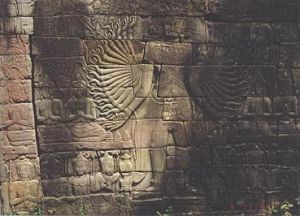 Never fully excavated and inaccessible for decades due to Khmer Rouge activity in the area, Banteay Chhmar (“Narrow Fortress”) was constructed late in the 12th century, allegedly as the funerary temple of King Jayarvarman VII’s son, the Crown Prince Indravarman and four generals killed in the war against the Chams. Other scholars have suggested it was built following the death of Rajapatindralakshmi, the paternal grandmother of the King. Along with its ruined face-towers, the temple is renowned for its bas-reliefs, which cover the outer face of the enclosing gallery and includes a unique sequence of multi-armed Lokitesvaras (left).
Never fully excavated and inaccessible for decades due to Khmer Rouge activity in the area, Banteay Chhmar (“Narrow Fortress”) was constructed late in the 12th century, allegedly as the funerary temple of King Jayarvarman VII’s son, the Crown Prince Indravarman and four generals killed in the war against the Chams. Other scholars have suggested it was built following the death of Rajapatindralakshmi, the paternal grandmother of the King. Along with its ruined face-towers, the temple is renowned for its bas-reliefs, which cover the outer face of the enclosing gallery and includes a unique sequence of multi-armed Lokitesvaras (left).
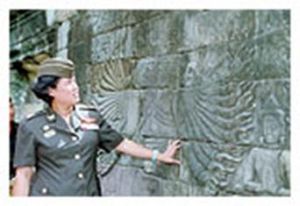 Unfortunately these carvings have been an irresistible magnet for looters in the last few years and this pillage plumbed new depths recently with the boldest and best-organised temple robbery of all time. In all, just under half of the temple’s wall carvings have now been removed but the latest theft was discovered by accident when Thai police stopped a truck carrying no less than 117 heavy stone pieces from a dismantled wall. This has prompted a major crackdown on the plundering of artefacts from the 1,200 ancient temples scattered across the country by both Cambodian and Thai authorities. A visit by Thai Princess Maha Chakri Sirindhorn to Banteay Chhmar has helped to raise awareness of the plight facing these remote Khmer temples and the above picture shows her inspecting one of the bas-reliefs still in place.
Unfortunately these carvings have been an irresistible magnet for looters in the last few years and this pillage plumbed new depths recently with the boldest and best-organised temple robbery of all time. In all, just under half of the temple’s wall carvings have now been removed but the latest theft was discovered by accident when Thai police stopped a truck carrying no less than 117 heavy stone pieces from a dismantled wall. This has prompted a major crackdown on the plundering of artefacts from the 1,200 ancient temples scattered across the country by both Cambodian and Thai authorities. A visit by Thai Princess Maha Chakri Sirindhorn to Banteay Chhmar has helped to raise awareness of the plight facing these remote Khmer temples and the above picture shows her inspecting one of the bas-reliefs still in place.
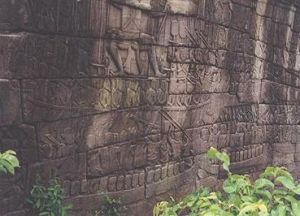 Banteay Chhmar originally covered an area of 2.5 x 2km (in comparison, Angkor Thom is 3km square) and contained the main sandstone temple, a number of other religious structures and a baray (1500 x 700m) to the east of the temple. Lying outside the moat-enclosed main temple’s eastern entrance is an isolated stone rest-house, known as a dharmasala (similar to the one found at Preah Khan in Angkor). A wall measuring 250 x 190 metres surrounds the temple proper, with four gopuras in the middle of each side. Its outer face carries bas-reliefs on three tiers showing alternating military and religious scenes, recalling those of the outer gallery of the Bayon, including battle scenes featuring the Chams (left). Although some parts of the wall have collapsed, the best of the reliefs are south of the gopura on the west wall and include a series of eight colossal standing, multi-armed Lokitesvaras, facing west.
Banteay Chhmar originally covered an area of 2.5 x 2km (in comparison, Angkor Thom is 3km square) and contained the main sandstone temple, a number of other religious structures and a baray (1500 x 700m) to the east of the temple. Lying outside the moat-enclosed main temple’s eastern entrance is an isolated stone rest-house, known as a dharmasala (similar to the one found at Preah Khan in Angkor). A wall measuring 250 x 190 metres surrounds the temple proper, with four gopuras in the middle of each side. Its outer face carries bas-reliefs on three tiers showing alternating military and religious scenes, recalling those of the outer gallery of the Bayon, including battle scenes featuring the Chams (left). Although some parts of the wall have collapsed, the best of the reliefs are south of the gopura on the west wall and include a series of eight colossal standing, multi-armed Lokitesvaras, facing west.
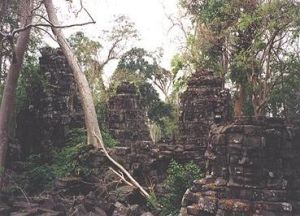 The confusing jumble of ruins that comprises the temple’s central complex gives the visitor no obvious route or path to follow and due to the tangled vegetation the best way of exploring is scrambling over gallery roofs and the large piles of collapsed stones. The long, narrow central sanctuary (170 x 40m) has interconnected galleries, gopuras and towers, both with and without carved faces (again, similar in style to those at the Bayon; pictured right). Near the centre, three face-towers stand in isolation amongst the ruins and undergrowth. To the north, west and south are three separate temples with more faces but most have collapsed and cannot be identified. Close by, a building known as the ‘Hall of Dancers’ houses a fine lintel showing half-human, half-bird apsaras, rishis and Brahma in excellent condition.
The confusing jumble of ruins that comprises the temple’s central complex gives the visitor no obvious route or path to follow and due to the tangled vegetation the best way of exploring is scrambling over gallery roofs and the large piles of collapsed stones. The long, narrow central sanctuary (170 x 40m) has interconnected galleries, gopuras and towers, both with and without carved faces (again, similar in style to those at the Bayon; pictured right). Near the centre, three face-towers stand in isolation amongst the ruins and undergrowth. To the north, west and south are three separate temples with more faces but most have collapsed and cannot be identified. Close by, a building known as the ‘Hall of Dancers’ houses a fine lintel showing half-human, half-bird apsaras, rishis and Brahma in excellent condition.
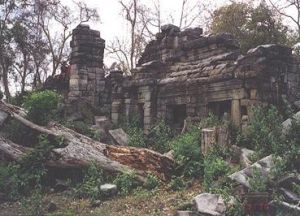 The temple complex lies sixty kilometres north of Sisophon along Route 69 and just thirteen kilometres from the Thai border. From Sisophon, it takes around 2 hours on a motorbike to travel the 43 kilometres to the village of Thmar Puok and then another seventeen kilometres to the south-west corner of the moat surrounding Banteay Chhmar. The road follows the moat around to the east side and a broad causeway, flanked by the baray, signals the entrance to the temple-city. Foreign visitors have so far been few and far between, although the improved security situation in the area will one day make the temple a popular diversion for those taking the overland route from Thailand into Cambodia via Poipet. A recent [2000] visitor to the site, Phalla from Angkor Adventures, confirmed that soldiers act as guides for the few travellers that make it up there and charge a $5 entrance fee. He took the pictures that you see above.
The temple complex lies sixty kilometres north of Sisophon along Route 69 and just thirteen kilometres from the Thai border. From Sisophon, it takes around 2 hours on a motorbike to travel the 43 kilometres to the village of Thmar Puok and then another seventeen kilometres to the south-west corner of the moat surrounding Banteay Chhmar. The road follows the moat around to the east side and a broad causeway, flanked by the baray, signals the entrance to the temple-city. Foreign visitors have so far been few and far between, although the improved security situation in the area will one day make the temple a popular diversion for those taking the overland route from Thailand into Cambodia via Poipet. A recent [2000] visitor to the site, Phalla from Angkor Adventures, confirmed that soldiers act as guides for the few travellers that make it up there and charge a $5 entrance fee. He took the pictures that you see above.
The photographs below, courtesy of Lisa Cox, are some of the stolen Banteay Chhmar friezes and carvings on display in the National Museum in Bangkok in March 2000. Under an agreement between the two countries, these sculptures will be repatriated back to Cambodia very soon but in the meantime they are on public display. They include two large wall bas-reliefs of multi-armed Lokitesvaras, large heads of asuras, a winged garuda, a stone inscription and other priceless artefacts.
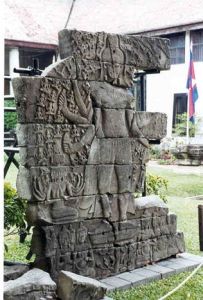
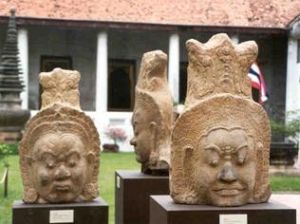
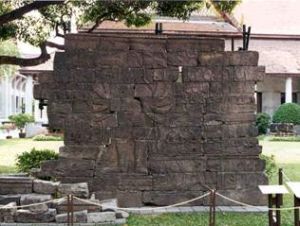
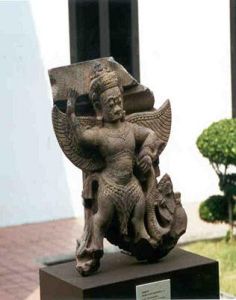
There are a lot more ruins tucked away in the remote north-western corner between Sisophon and the former Khmer Rouge stronghold of Anlong Veng in the north. Continuing on from Banteay Chhmar, a large complex called Banteay Top (‘Army Citadel’) lies a few kilometres away in deep jungle and along with a handful of other temples, Prasat Mebon, Prasat Taphrom, Prasat Samnang Tasok and Prasat Ta Preav could form a tourist circuit in the future, according to UNESCO and the Ministry of Culture, who have installed guards and cleared vegetation in recent months. There’s also Prasat Rovieng, an early brick structure on Route 69, near Bak Noem and an Angkorean period bridge on Route 68 south of Chong Kal, with a fairly large Angkor-era structure nearby.
If you have any more information on these sites, please let me know, I can be contacted by e-mail on: andy.brouwer@btinternet.com or for more information on Andy’s travels, visit his website which has lots of travelogue stories with pictures: http://www.btinternet.com/~andy.brouwer/index.htm
